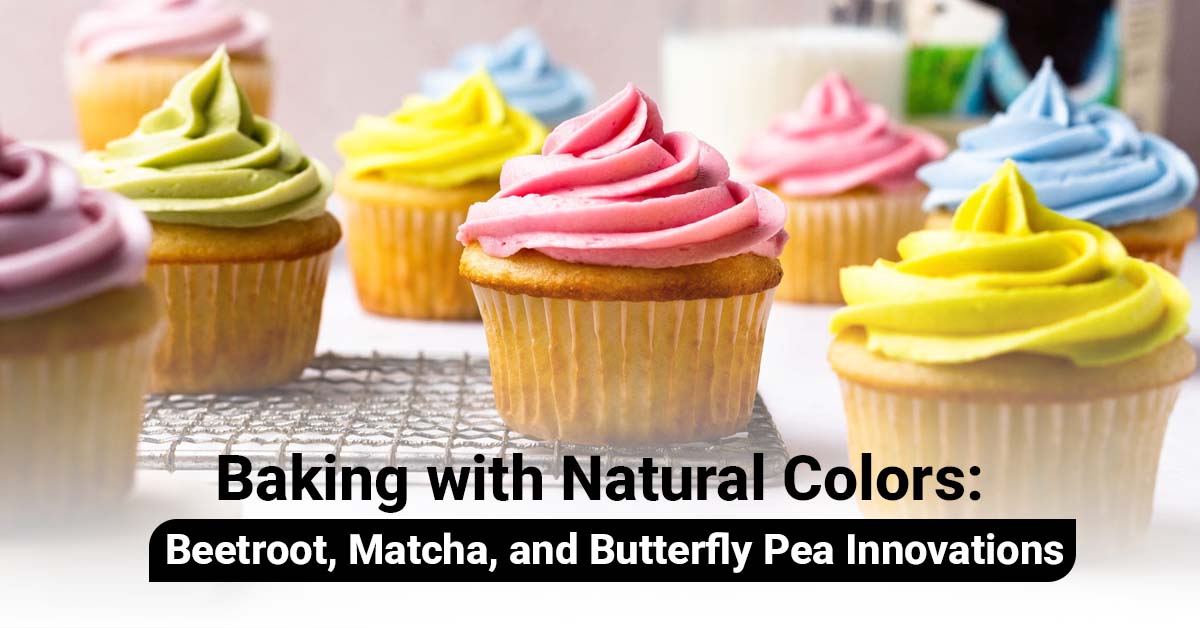Artificial colors may be visually attractive, but an increasing number of bakers are opting for natural ones that not only provide the same brightness but also add nutritional value. If you are simply experimenting at home or enhancing your professional skills, mastering natural pigments can really take your work to the next level. Nowadays, as more students get interested in colour-focused desserts while doing a professional bakery course in Chennai and so, the demand for products like beetroot, matcha and butterfly pea keeps rising.
In this blog, We will discuss the behavior of these components in flours, batters and icings, as well as their creative use without giving up on the taste and texture.
Why Natural Colours Work So Well
Clean ingredients do not just help make the baking look nice. They also bring antioxidants, unique flavours and add interesting elements . For instance, beetroot can provide bright pinks and reds without giving too much of its sweet side; similarly, matcha can bring earthiness along with bright green color; butterfly pea can be used to provide soothing blue and purple color.
Natural tints are different from artificial colours in that their response is to heat, acidity and fat content. Hence, knowing their properties can help bakers get consistent results.
Beetroot: Bold and Versatile
Beetroot is the one to make your colour range from soft pink to dark burgundy. Its natural flavor is quite neutral to most desserts, especially if it is roasted or made into powder.
How it behaves in baking: Beetroot is a great match for butter-based batters like cakes, muffins and brownies. The pigment (betanin) is very heat sensitive, thus a shorter baking time will help to keep the colour intact.
Where to use it: Beetroot can be used to make stunning sponges, chocolate cakes and cookies. If used in icing, beet powder will give a vibrant colour without adding a lot of liquid, thus making it easier to get the desired consistency.
Beetroot is the source of water as well, it allows the baked goods to be kept soft for a longer period of time. Besides that, it also goes well with chocolate and citrus, whereby the latter balances the former’s sweetness with its subtle nature.
Matcha: A Balance of Taste and Pigment
Matcha lends baked goods a fresh grassy flavour and a vibrant green colour. Its colour is due to chlorophyll, which is a pigment that retains its colour quite well at moderate temperatures but can become dull if heated too much.
Proper use of matcha
One thing that matters is quality. Better-grade matcha will produce a more vivid colour and a more pleasing flavour. It also mixes best when it is sifted with the dry ingredients of the batter.
What it helps
- Matcha can be used to great effect in:
- Butter cookies and sablés
- Swiss rolls and layer cakes
- Glazes and whipped creams
Also, it looks great in trendy fusion desserts like matcha-misu or matcha choux. Since it is naturally bitter, the addition of white chocolate or vanilla will help to even out the flavour.
Butterfly Pea: Subtle and Transformative
For its gentle colour changes, from bright blue to purple when a sour taste is added by butterfly pea flower has been widely used. In contrast to matcha, the taste of which is rather neutral, the taste of the flower is also neutral, so it can be used easily if the colour is the main point.
How it works
The pigment is the part which changes depending on the pH. If you give it some citrus, the blue will be changed into a lilac immediately. If you give it dairy or neutral ingredients, the colour will still be blue.
Best uses
Butterfly pea is the best ingredient for chiffon cakes, milks, glazes and laminated pastries. Its colours are comforting and aesthetically elegant just right for the modern patisserie.
Key Considerations for Natural Colouring
Natural colours are available in three forms such as powders, extracts or purées. Powders are the most suitable as they keep the consistency intact without the batter being over-hydrated. Purées, on the other hand, add moisture and thus change the texture, you may have to make some adjustments.
Heat and pH
Colour changes for one thing: natural pigments are highly sensitive. Their colour can change when they are heated to a very high temperature or when they come in contact with an acidic substance. That is why it is necessary to experiment with temperature and type of batter to get the desired result.
These intricacies are conveyed in a formal setting, where students learn to adjust the formula and recognize the reaction of pigments in different pastry formats.
Why Training Makes a Difference
Natural colours are super fun, but getting them right takes more than just trial and error. Learning in a professional setting is mainly about technique, understanding the ingredient and the way of application:
- Students figure out how colour changes with fat, heat and leavening.
- They become brave and daring with natural pigments in laminated doughs, sponges, frosting and glazes.
- They delve into flavour pairing, very important when colour sources are also the most flavouring ones.
Being able to watch the work being done, solving problems and having the practice under the teacher’s guidance makes a great difference. It cuts down the time needed to learn and gives bakers the power to make beautiful desserts visually and keep the taste delicious.
That is the reason why a lot of chef students decide to go to the Professional Bakery Class. They get organized instruction to help them execute their creative ideas with accuracy.
Using natural colour is not a trend, it is a deliberate choice that comes from the aspects of health, taste and creativity. These three – beetroot, matcha and butterfly pea, prove that colour can be very neat, stylish and vibrant without the need for artificially made additives.
Bakers discover by trial and error how these ingredients work in different recipes and how they can change their methods to get the same results each time. If you want to delve deeper into these dyes and develop the skill of working with them confidently, our baking classes in Anna Nagar would be a perfect way to learn colour, texture and flavour with a given goal and many more.


